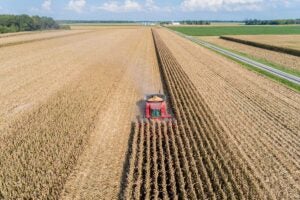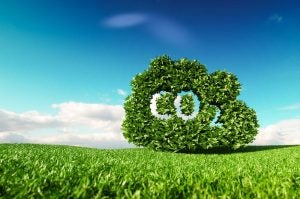Carbon credits as a concept have been around for years, and there can be a lot to know about carbon credits and participating in a carbon program. Here is what is most important about those carbon credits in the agriculture sector.
A carbon credit is created from carbon offset, which means doing something that prevents the emission of carbon dioxide or other greenhouse gasses. One carbon credit equals one metric ton of carbon dioxide. Carbon credits can be created by any project that reduces, destroys, or captures emissions, but they are most often created through sustainable agricultural practices. These credits can be bought and sold and can help companies to achieve greenhouse gas (GHG) reduction goals.
Carbon credits are sold on two different markets: compliance markets and voluntary markets. Compliance markets support programs that require GHG reductions. Voluntary markets support people trying to achieve their own voluntary GHG reduction goals. The amount of voluntary credits issued has been increasing and will likely continue to increase.
Voluntary credits serve as a tool for agriculture to reduce its GHG emissions. Carbon credits also offer a way for companies to achieve GHG reductions from the ag and forestry sectors. Purchasing carbon credits from agriculture gives these companies access to GHG reductions from outside of their facilities. Carbon credits also serve as a potential source of income for farmers and ranchers, even for things that the producer might already be doing, such as reduced tillage, manure management, or planting cover crops.
Some of the ways that agriculture is creating carbon credits is by increasing carbon reservoirs in our soil through soil carbon sequestration. This can be done by moving excess carbon from the atmosphere to the soil or by implementing agricultural management practices that keep carbon in the soil. These can be done by using cover crops or no-till practices. Methane digesters are another agricultural project that can create carbon credits. Reducing the use of nitrogen fertilizer, improved livestock management procedures, and restoring degraded wetlands are just a few other ways to generate carbon credits.
Lots of data points to the growing of a 160 bushel corn crop with modern agricultural practices as essentially being carbon neutral. With a slightly higher yield, the crop becomes a net carbon sink. Two hundred bushel corn crops are not uncommon in the U.S.

Currently, there are carbon credits issued for agriculture, chemical processes, forestry, land use, industrial and commercial industries, renewable energy, waste management, and a few others. In order to know your number of carbon credits, you need to know the accurate numbers of GHG emissions and carbon sequestration before and after a project. It can be challenging to determine these numbers in the ag and forestry industries. GHG emissions are generally measured through modeling and site-specific measurements that do their best to estimate GHG emissions. There are emerging technologies, such as the use of artificial intelligence and machine learning, that have the potential to more accurately determine GHG emissions.
There are several different carbon credit programs that producers can enroll in to generate carbon credits. Each of these programs is different in their requirements and return on investment. It can be hard for producers to decide between which program would work best for their operation. Before enrolling in a carbon credit program, anyone who is interested should do their own research into what would work best for their farm, ranch, land, or forest. Some examples of carbon credit programs that farmers can enroll in are Corteva’s Carbon Initiative, the Bayer Carbon Program, or Nutrien’s Carbon Program.
Additionally, companies such as Indigo Ag, which specializes in biological products, offers farmers a set price for initiating certain practices like cover crops. These become a Carbon Credit Reserve, which is then sold to emitting companies. Indigo claims they share about 75 percent of the revenue with participating farmers.
Recent surveys have found that most producers (93 percent) are aware of carbon markets, but only 3 percent of producers are actually enrolled in a carbon credit program. Some of the barriers that keep farmers and ranchers from enrolling in a program are concerns about the return on investment, lack of awareness or knowledge on how to enroll, the costs to determine GHG emissions, the costs to verify the integrity of carbon credits, and general concerns over the amount of time and effort that would have to go toward generating carbon credits. The U.S. Department of Agriculture has outlined some ways to address some of these concerns and barriers that are stopping farmers from enrolling.

Carbon credits serve to offset carbon and other GHG emissions. Carbon credits are normally generated through sustainable agricultural practices. They have the potential to provide farmers with another source of income, help agriculture increase its sustainability, and provide other companies not in the ag sector with a way to meet their GHG reduction goals. There are different carbon credit programs available to farmers, and each producer should do their own research on which program would work best for them.
Michelle Miller, the “Farm Babe,” is an internationally recognized keynote speaker, writer, and social media influencer and travels full time to advocate for agriculture. She comes from an Iowa-based row crop and livestock farming background and now resides on a timber farm in North Central Florida.



